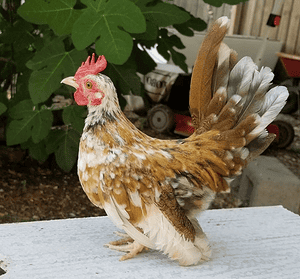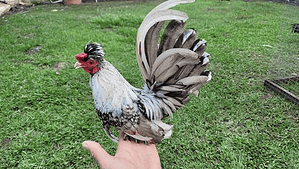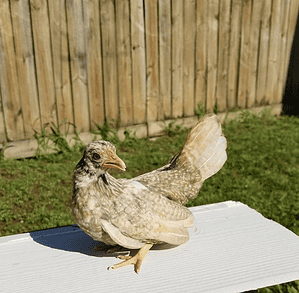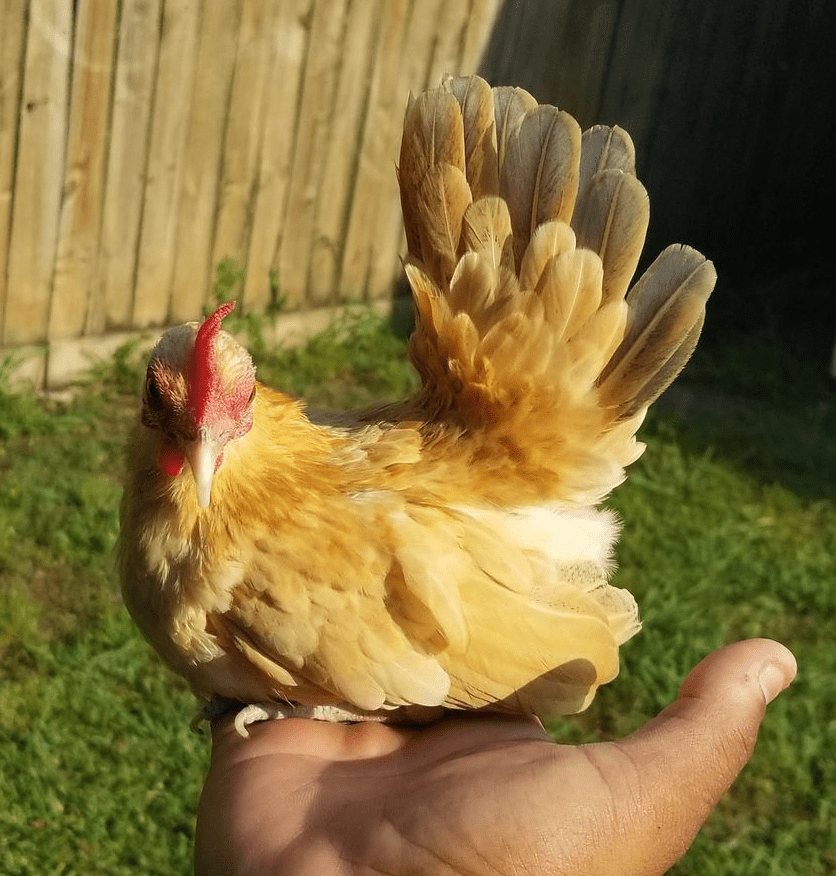Kikiriki chickens, also called Malay Serama or Serama chickens, are used mostly for ornamental purposes rather than for their egg or meat production. Their behavior is generally gentle and friendly, making them ideal pets. Hens lay small eggs and will go broody. Kikiriki roosters are less aggressive than other breeds.
If you’re interested in learning more about the Kikiriki chicken, the smallest breed in the world, keep reading. We’ll discuss the origin, behavior, characteristics, hatching chicks, and more about these small chickens.
Kikiriki Chickens
This chicken breed is a native of Kelantan, the Malaysian State. The breed is believed to have resulted from cross-breeding between the Japanese bantams with the Malay breed.
The modern breed of Kikiriki chicken is due to Wee Yean Een’s development, who named the species in honor of Rama Serama, the title of the King of Thailand. This chicken was first displayed in 1990 and again in 2004, but bird flu killed most of these birds.
Various organizations promote the Kikiriki breed within the United States, like the Serama Council of North America, which helped introduce this breed to many of the nation’s poultry shows. In addition, the American Bantam Association and the American Poultry Association approved the “American Serama variety” in 2011. Learn more about Serama chickens.
Temperament
Since its feathers are attractive, people often keep this breed as an ornamental bird. It’s a breed with an incredibly calm and peaceful nature that makes them simple to handle. These days, the Kikiriki chicken is becoming popular as a pet because it can be friendly with other people quickly.

Kikiriki Rooster
A Kikiriki rooster will do a good job protecting his flock. However, he is a small rooster with a less robust presence than roosters from larger breeds. He will crow less loudly and likely overall be less fierce. Therefore, Kikiriki roosters may not be as threatening to larger predators.
Keep Kikiriki hens and roosters with only Kikirikis or with bantams of other mild-mannered breeds due to their small size. The roosters can be bullied by other roosters that are more domineering and larger.
If you want to keep your hens protected or you want to hatch fertile eggs, you can keep a Kikiriki rooster. Learn about raising roosters. Be sure to have at least 8 – 10 hens per rooster.
Hardiness
Because these are tiny chickens, they will not do as well in cold climates. They do best in moderate climates. If there is a cold spell, be sure they stay dry and warm in a well-ventilated, draft-free shelter.
Characteristics
Kikirikis are small and expected to live for 7 years, but in most cases, they can live until the age of 10 years. They make a tremendous ornamental bird or pet because people consider it the smallest chicken in the world. They don’t need a lot of space. Kikiriki roosters weigh around 500 grams while females are 425 grams.
In addition to being small, Kikiriki chickens also have the following traits:
- Short, muscular body with a high chest
- The wings are large relative to the size of the body
- The tail points upwards, and its feathers are large
- Small head
- Their legs are straight, long, and wide

Kikiriki Eggs
Just like with eggs from bantam chickens, Kikiriki chicken eggs are small. They lay eggs that range in color from golden light brown to cream and white. You will also find speckled eggs occasionally, though this is a rare occurrence.
Their eggs weigh between 14 and 25 grams or about three-quarters to an ounce in weight. Kikiriki hens are very productive and can lay all year when kept in appropriate conditions. You can eat the eggs they produce. They are just like eggs from other chickens, but they are much smaller. You need three eggs from a Kikiriki chicken to get the same quantity as one contemporary hybrid chicken egg.

Reproduction
The Kikiriki breed’s egg production and fertile season start in January to February and again from November until December. The females can produce 5 to 7 eggs each month, ranging from beige to white. The chicks require around 19 days to incubate and develop before they hatch. (Larger chicken breeds generally take 21 days to incubate.)
They are carriers of a diluted deadly gene inherited from the Japanese bantam ancestry that causes failure of 1 and 2% of fully developed embryos to not hatch or die within 24 hours after hatching.
Typically, Kikiriki hens go broody and make excellent mothers. However, each chicken will have its own personality.
After hatching, the chicks need between 16 and 18 weeks to mature, at which point they can reproduce. One thing to keep in mind is that, since it’s a tiny breed, chicks can be very susceptible to cold. Therefore, you must keep your chickens in warm areas to keep them from becoming sick or dying.
Kikiriki chickens aren’t always able to breed to size. Out of the chicks born, you can expect a small portion to be tiny (A-class), 10% or more to be big (C Class), and the rest will fall within the normal range of size for Kikiriki chicken.
Kikiriki Chicken Colors
The American Poultry Association recognizes the American Serama, white variety, in the Single Comb, Clean-Legged (SCCL) class.
Kikiriki chickens can be be in many different colors. They are not chosen for color, and they do not always have true breeding for color. Some of color varieties are:
- White
- Black
- Blue
- Brunette
- Chocolate
- Black colored with white
FAQ’s
What is a Kikiriki chicken?
Also called Seramas, Kikiriki chickens are the smallest chickens in the world. They lay eggs but being they are so small, that isn’t typically a reason someone would choose to raise them. They are ideal for ornamental purposes and as pets.
What is the smallest chicken breed?
Kikiriki chickens, also called Serama chickens, are the smallest chicken breed.
What breed of chickens are best for beginners?
Choosing friendly and mild-mannered chickens is a good choice for beginner flock keepers. You could choose bantam varieties which are smaller chickens than standard-sized. Consider your purpose for wanting to raise chickens. There are some better for eggs, others better for meat, some that are dual-purpose (good for eggs and meat) and others, like Kikirikis, that are tiny and friendly but are more for ornamental purposes than for homesteading for food.
Raising Kikiriki Chickens
Because of their pocket size, it is essential to protect Kikiriki chickens from freezing temperatures. They are tiny and thrive in warmer climates. They might suffer in cold climates.
This small chicken breed makes an excellent pet. A Kikiriki rooster’s crow isn’t too noisy, and they are social with people. Why do roosters crow
The incubation time for Kikiriki Serama eggs is between 19 and 20 days. Kikiriki hens are competent mothers and adept at being on the ground sitting on the eggs, brooding, and hatching while caring for their babies.
The chicks are tiny after hatching, and during the first three weeks of life, you must crush the chick’s crumb into a fine powder that aids in digestion. You can do this with any device, like a coffee grinder, or pestle and mortar. Fully-grown chickens will eat regular chicken feed if you use small pellets or bantam.
Like most all chickens, this breed will enjoy fresh air and the opportunity to free range out in the sun during the warm summer days to hunt and forage among the grass. But when they’re outside, you need to keep an eye on them. They are small and can easily fall prey to cats, raccoons, possums, and other predators.
When keeping the world’s smallest chicken, it will be vitally important to keep them safe. This includes keeping them protected from the weather as well as natural predators.
You should also provide them with a place to shelter or a coop where they can sleep, lay eggs, and roam free.
Consider, also, their flock mates. Chickens have a pecking order. Oftentimes, the largest and loudest are the most aggressive. Being Kikirikis and Seramas are so small, it will be important to keep them with others of the same breed or bantams so they aren’t overpowered by bully chicken breeds.
Even though they are small, they still need room. Avoid competition with food and water by having several chicken feeders and chicken waterers.
Conclusion
Raising chickens as pets is a great way to have fresh eggs, fertilize your garden, and enjoy the company of these beautiful animals. Chickens are social animals that thrive on human interaction. They are also very easy to care for and provide many benefits to the owner.
Even though this breed is smaller, they can be noisy at times, so it is important to consider these factors before deciding if they would make a good pet. Consider the proximity to your neighbors. Like all pets, they also require some time and effort on the part of their owner.

